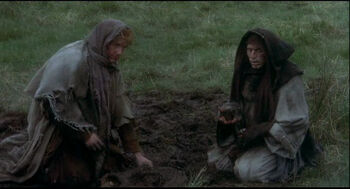The Ruling Class[]
For the oceans of ink gushed upon this subject, see First Godking Court.
Urban and Rural[]
For the vast majority of the population at the bottom rung of society, the advent of the Godking changed very little in material conditions. The caste division between urban labourers and rural farmers, which had existed for half a millennium before the Godking, persisted essentially unchanged throughout the period.
Archaeology confirms that the rural poor had a somewhat more varied diet and larger homes than urbanites; from their bones, they were more likely to suffer serious injury but less subject to disease; post-infancy life expectancy was about five years longer. They were almost universally illiterate, however - an estimated 70% of urban labourers had basic literacy.
The ritual forms of burial, marriage, festival and worship were almost completely different between these populations, leading to countless inconclusive attempts to prove a separate ethnic origin. Certainly, there was a strong cultural emphasis on the division; for instance, rural migrants to the city invariably took new names in the urban style, which makes it very hard to tell how much migration actually went on. The problem with the separate-origin hypothesis is that apart from a handful of specialist terms (which just show that there were no beekeepers in the city or sewer-workers in the country), there was really very little linguistic difference between the two. Urban and rural commoners seem to have told the same folk-tales, played the same games, and drunk the same yarrow-flavoured beer from the same pots in the same layout of bath-house.
A Middle Class?[]
Whether anything resembling a 'middle class' existed in the Godking Period remains a topic of considerable debate. It is undeniable that the great majority of victims of the Court of the Final Atonement were neither unskilled labourers nor members of the ruling class. The extent to which the purges destroyed specialised vocations and disrupted trade, however, is fiercely debated. Similarly, it was long believed that the Godking's destruction of the Arcades of Celestua completely severed trade routes, effectively terminating long-distance trade and the professions needed to support it.
Until the past couple of decades, the standard narrative was that the Purge effectively wiped out the urban middle class, and that the artisan, bureaucratic and financial class extant by the close of the Godking Period were a wholly new creation, a mix of immigrant traders, court hangers-on and second-generation Divine Blood. Modern reappraisals, largely by Minyaphone ethnomaterialists, suggest that once you get past the famous names, the Purge's victims were primarily rural, intended to reform the ungovernably complex organisation of land use by wiping out small landowners, surveyor-advocates, boundsmen, parish clerks and sinecure-holders. The urban middle class lost their more senior figures and their institutions were thrown into chaos, but the actual crafts and trades, together with most of the people who practised them, were left essentially intact. A network of smaller, regional trade hubs, according to this account, maintained much of the trade capacity of Celestua, and this led to a larger, more widely-dispersed merchant class than had previously existed.
The archaeological record is not much help here. Some sites that look rather like the purported regional

A regional trade hub (artist's impression).
trade hubs have been excavated, but none of them seem to be much more than local market-towns. Long-distance trade, it now seems clear, had declined substantially, with a focus shifting towards smaller volumes and high-value, portable goods. The proliferation of small luxury items might be a sign that there were people outside the Court wealthy enough to create demand for them - but then, given that first the Purge and then the fall of the monarchs had occasioned looting on an unprecedented scale, one would expect a lot of valuables to have been put back in circulation.
Analysis of middens from the tell at Erissa suggest that, outside the court, the urban population during the Early Godking were fairly uniform in dietary composition: everyone ate mutton, barley-bread, tree fruit, and ostrich when they could get it. (A higher ratio of lamb and ostrich bones to mutton in the Qumrab and Detta districts has been cited as evidence for these being resurgent middle-class neighbourhoods, but the pattern is tenuous, and doesn't match up with house-size patterns or census rolls at all.) Since these foods are all local products, the assumption was that only the courtier class ate imported foodstuffs; the advent of chemical analysis has revealed that everyone was eating a fair amount of small, oily fish - probably Naba Sea eulachon - which must have been imported.
If an urban middle class existed in the Early Godking Period, then, it seems reasonable to infer that they were distinguished not so much by material or linguistic culture as by literacy, leisure time, social influence and Court connections.